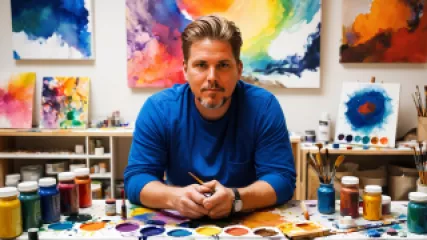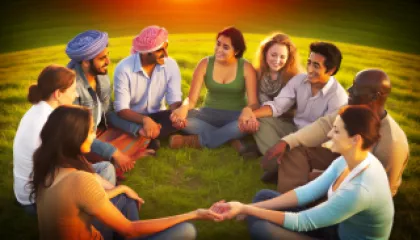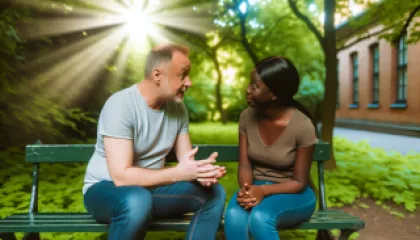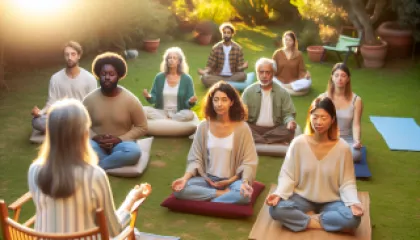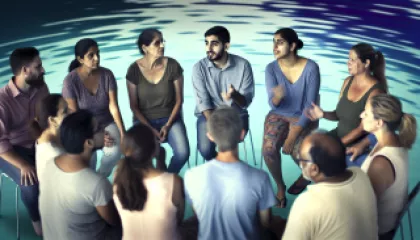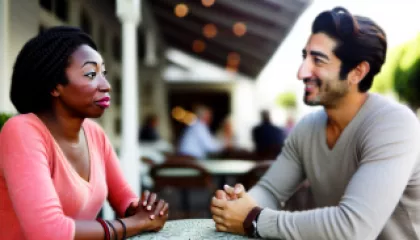My Journey Into Mindfulness Art Therapy
My Journey Into Mindfulness Art Therapy
My name is Weston Jackson, and I want to share with you the incredible healing journey I've experienced through the power of mindfulness art therapy. For years, I struggled with the lingering effects of childhood trauma, feeling lost and disconnected from my true self. It wasn't until I discovered the transformative practice of art therapy that I began to uncover a path towards wholeness and inner peace.
As someone who had always found solace in creative expression, the idea of using art as a tool for personal growth and healing immediately resonated with me. I had dabbled in various artistic pursuits throughout my life, but it wasn't until I embarked on this journey that I truly understood the profound impact that the creative process could have on the mind, body, and spirit.
Uncovering the Roots of Trauma
My path to mindfulness art therapy began with a deep desire to confront and heal the trauma that had been weighing me down for so many years. Growing up, I experienced a tumultuous home life, marked by emotional abuse and neglect. The scars of those experiences had followed me well into adulthood, manifesting in feelings of unworthiness, anxiety, and a profound sense of disconnection from myself and the world around me.
For a long time, I tried to ignore the pain, burying it deep within and relying on unhealthy coping mechanisms to get through each day. But the weight of my unresolved trauma only continued to grow heavier, until I reached a breaking point where I knew I had to confront it head-on.
It was then that I discovered the transformative power of mindfulness art therapy. Through the guidance of a trained therapist, I began to explore my inner landscape through the medium of art, using brushstrokes, clay, and various other materials to give form to the emotions and experiences that had been locked away for so long.
Embracing the Creative Process
As I delved into the world of art therapy, I was struck by the way it allowed me to access and express the deepest parts of myself that I had been suppressing. The act of creating became a sacred ritual, a space where I could confront my fears, unpack my trauma, and begin the process of healing.
At first, the process was challenging and uncomfortable. I found myself resisting the urge to create, afraid of what might emerge from the depths of my subconscious. But with the support and encouragement of my therapist, I gradually learned to surrender to the creative flow, allowing my intuition to guide my hand as I explored various mediums and techniques.
As I immersed myself in the creative process, I began to notice subtle shifts within myself. The act of expressing my emotions through art helped to alleviate the intensity of the feelings, allowing me to observe them with a greater sense of detachment and clarity.
"Art therapy has been a game-changer for me. It's given me a safe and nourishing way to confront my trauma and reclaim my sense of self. Through the creative process, I've been able to tap into the wisdom of my body and access parts of myself that were previously hidden."
- Weston Jackson
I found that the more I engaged with art therapy, the more I began to cultivate a sense of mindfulness and self-awareness. The act of focusing intently on the present moment, of allowing my senses to guide the creative process, helped to quiet the relentless chatter of my mind and bring me into a state of profound presence and connection.
The Healing Journey
As I continued to delve deeper into the world of mindfulness art therapy, I began to experience profound shifts in my overall well-being. The act of creating became a sacred ritual, a way for me to process my emotions, release tension, and tap into the innate wisdom of my body and spirit.
Through the creation of abstract paintings, intricate mandalas, and sculptural pieces, I was able to give tangible form to the emotions and experiences that had been weighing me down. Each artwork became a snapshot of my inner landscape, a reflection of the healing and transformation that was taking place within me.
As I poured my heart and soul into these creative expressions, I began to notice a corresponding shift in my mental and emotional state. The anxiety and feelings of unworthiness that had once dominated my life gradually began to dissipate, replaced by a growing sense of self-acceptance, inner peace, and a deeper connection to the world around me.
It was as if the act of creating had opened up a portal to a new way of being, one that was rooted in mindfulness, self-compassion, and a profound reverence for the healing power of the creative process.
Embracing the Artistic Healing Journey
Today, I can say with certainty that mindfulness art therapy has been the single most transformative experience of my life. Through this practice, I have been able to confront and heal the wounds of my past, reclaim my sense of self, and cultivate a deep, abiding connection to the creative source that exists within all of us.
The journey has not been an easy one – there have been moments of great struggle and vulnerability, times when the process of unearthing my trauma felt overwhelming and painful. But with the support of my therapist and the guidance of the creative process, I have been able to navigate these challenges with a newfound sense of resilience and self-trust.
As I reflect on the profound changes I have experienced, I am filled with a deep sense of gratitude and reverence for the power of art as a tool for healing and personal transformation. Through the act of creating, I have been able to tap into the wellspring of my own inner resources, discovering hidden strengths and untapped potentials that I never knew existed.
"The transformative power of art therapy has been a revelation to me. It's allowed me to reclaim my sense of self, to process my emotions in a healthy and constructive way, and to cultivate a deep, abiding connection to the creative source that resides within all of us. This journey has been a true gift, and I am forever grateful for the profound healing it has brought into my life."
- Weston Jackson
If you're someone who has been struggling with the lingering effects of trauma, anxiety, or a general sense of disconnection from yourself and the world around you, I encourage you to consider the transformative power of mindfulness art therapy. It has been a true lifeline for me, and I believe it has the potential to unlock profound healing and self-discovery for anyone who is willing to embrace the creative process with an open heart and mind.
Unleashing the Transformative Power of Art Therapy
At the heart of my healing journey through mindfulness art therapy lies a deep belief in the power of creative expression to catalyze personal growth and transformation. Through the act of creating, I have been able to access and process emotions that were previously locked away, giving them a tangible form and allowing me to engage with them in a more conscious and constructive way.
One of the key aspects of this practice that has been so impactful for me is the way it encourages a profound sense of mindfulness and presence. As I immerse myself in the creative process, whether it's painting, sculpting, or working with various other mediums, I find myself fully engaged in the here and now, my senses attuned to the sensations and textures of the materials I'm working with.
This state of heightened awareness and presence has had a profound effect on my overall well-being, helping to quiet the incessant chatter of my mind and allowing me to tap into a deeper, more intuitive understanding of myself and the world around me. It's as if the creative process has become a gateway to a more expansive and authentic way of being, one that is rooted in self-acceptance, self-compassion, and a profound sense of connection to the creative source that resides within all of us.
Uncovering the Wisdom of the Body
Another transformative aspect of my experience with mindfulness art therapy has been the way it has allowed me to access and honor the deep wisdom of my body. Throughout my life, I had often felt disconnected from the physical vessel that houses my spirit, treating it as a mere instrument to be used and pushed to its limits.
But through the creative process, I've learned to listen more closely to the subtle whispers of my body, allowing its innate intelligence to guide the way I engage with the materials and techniques of art therapy. I've discovered that the body holds a profound wellspring of knowledge and insight, and that by tuning into its rhythms and sensations, I can access a deeper level of self-understanding and healing.
Whether it's the fluidity of my brushstrokes, the tactile experience of working with clay, or the meditative focus required to create an intricate mandala, I've found that the creative process has a way of bridging the gap between mind and body, allowing me to cultivate a harmonious integration of the two.
Tapping into the Collective Healing Power of Art
As I've delved deeper into the world of mindfulness art therapy, I've also come to appreciate the profound ways in which the creative process can connect us to a larger, collective experience of healing and self-discovery. Throughout human history, art has played a crucial role in the process of processing trauma, expressing emotions, and fostering a sense of community and shared understanding.
When I create a piece of art, whether it's a painting, a sculpture, or a mixed-media collage, I'm not just engaging in a solitary act of self-expression. I'm tapping into a lineage of artists, healers, and visionaries who have used the power of creativity to transform themselves and the world around them.
In this way, the act of creating becomes a deeply spiritual and connective experience, one that allows me to feel a sense of belonging and reverence for the collective human journey of growth, healing, and transcendence. By honoring the wisdom and creative expression of those who have come before me, I've been able to cultivate a deeper sense of purpose and belonging within my own artistic healing journey.
Embracing the Path of Mindfulness Art Therapy
As I look back on the transformative journey I've undertaken through the practice of mindfulness art therapy, I am filled with a deep sense of gratitude and awe. This practice has not only helped me to confront and heal the wounds of my past, but it has also opened up a world of profound self-discovery and personal growth.
Through the creative process, I have been able to tap into the wellspring of my own inner resources, uncovering hidden strengths and untapped potentials that I never knew existed. I have learned to listen more closely to the whispers of my body and spirit, allowing their wisdom to guide the way I engage with the materials and techniques of art therapy.
And perhaps most importantly, I have cultivated a profound sense of connection – to myself, to the collective human experience of healing and transformation, and to the creative source that resides within us all. It is this deep sense of connection that has been the most transformative and sustaining aspect of my journey, providing me with a anchor point of stability and self-trust even in the midst of challenging times.
If you are someone who has been struggling with the lingering effects of trauma, anxiety, or a general sense of disconnection from yourself and the world around you, I encourage you to consider the transformative power of mindfulness art therapy. It has been a true lifeline for me, and I believe it has the potential to unlock profound healing and self-discovery for anyone who is willing to embrace the creative process with an open heart and mind.
"Through the act of creating, I have been able to access and process emotions that were previously locked away, giving them a tangible form and allowing me to engage with them in a more conscious and constructive way. The creative process has become a gateway to a more expansive and authentic way of being, one that is rooted in self-acceptance, self-compassion, and a profound sense of connection to the creative source that resides within all of us."
- Weston Jackson
So if you're feeling called to embark on your own artistic healing journey, I encourage you to take that first step, to trust in the process, and to embrace the transformative power of mindfulness art therapy with an open heart and mind. The road ahead may not be easy, but the rewards of this journey are truly profound and life-changing.
Embracing the Transformative Power of Creative Expression
As I've delved deeper into the world of mindfulness art therapy, I've come to understand the profound ways in which the creative process can serve as a catalyst for personal growth, emotional healing, and spiritual transcendence. Through the act of creating, we are able to access and give tangible form to the deepest parts of ourselves, unlocking a wellspring of insight, self-understanding, and inner transformation.
One of the most powerful aspects of this practice, in my experience, is the way it encourages a deep state of mindfulness and presence. When I'm engaged in the creative process – whether it's painting, sculpting, or working with various other mediums – I find myself fully immersed in the here and now, my senses attuned to the textures, colors, and sensations of the materials I'm working with.
This heightened state of awareness and focus has a remarkable effect on my overall well-being, helping to quiet the relentless chatter of my mind and allowing me to tap into a deeper, more intuitive understanding of myself and the world around me. It's as if the creative act serves as a gateway to a more expansive and authentic way of being, one that is rooted in self-acceptance, self-compassion, and a profound reverence for the creative source that resides within all of us.
Honoring the Wisdom of the Body
Another transformative aspect of my experience with mindfulness art therapy has been the way it has allowed me to access and honor the deep wisdom of my body. Throughout my life, I had often felt disconnected from the physical vessel that houses my spirit, treating it as a mere instrument to be used and pushed to its limits.
But through the creative process, I've learned to listen more closely to the subtle whispers of my body, allowing its innate intelligence to guide the way I engage with the materials and techniques of art therapy. I've discovered that the body holds a profound wellspring of knowledge and insight, and that by tuning into its rhythms and sensations, I can access a deeper level of self-understanding and healing.
Whether it's the fluidity of my brushstrokes, the tactile experience of working with clay, or the meditative focus required to create an intricate mandala, I've found that the creative process has a way of bridging the gap between mind and body, allowing me to cultivate a harmonious integration of the two.
Tapping into the Collective Healing Power of Art
As I've delved deeper into the world of mindfulness art therapy, I've also come to appreciate the profound ways in which the creative process can connect us to a larger, collective experience of healing and self-discovery. Throughout human history, art has played a crucial role in the process of processing trauma, expressing emotions, and fostering a sense of community and shared understanding.
When I create a piece of art, whether it's a painting, a sculpture, or a mixed-media collage, I'm not just engaging in a solitary act of self-expression. I'm tapping into a lineage of artists, healers, and visionaries who have used the power of creativity to transform themselves and the world around them.
In this way, the act of creating becomes a deeply spiritual and connective experience, one that allows me to feel a sense of belonging and reverence for the collective human journey of growth, healing, and transcendence. By honoring the wisdom and creative expression of those who have come before me, I've been able to cultivate a deeper sense of purpose and belonging within my own artistic healing journey.
Embracing the Transformative Power of Mindfulness Art Therapy
As I reflect on the profound changes I've experienced through the practice of mindfulness art therapy, I am filled with a deep sense of gratitude and awe. This journey has not only helped me to confront and heal the wounds of my past, but it has also opened up a world of profound self-discovery and personal growth.
Through the creative process, I have been able to tap into the wellspring of my own inner resources, uncovering hidden strengths and untapped potentials that I never knew existed. I have learned to listen more closely to the whispers of my body and spirit, allowing their wisdom to guide the way I engage with the materials and techniques of art therapy.
And perhaps most importantly, I have cultivated a profound sense of connection – to myself, to the collective human experience of healing and transformation, and to the creative
